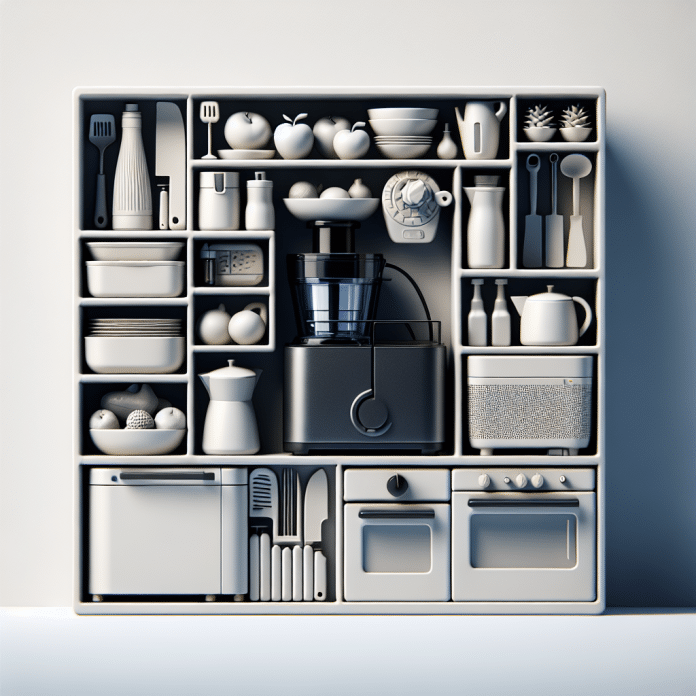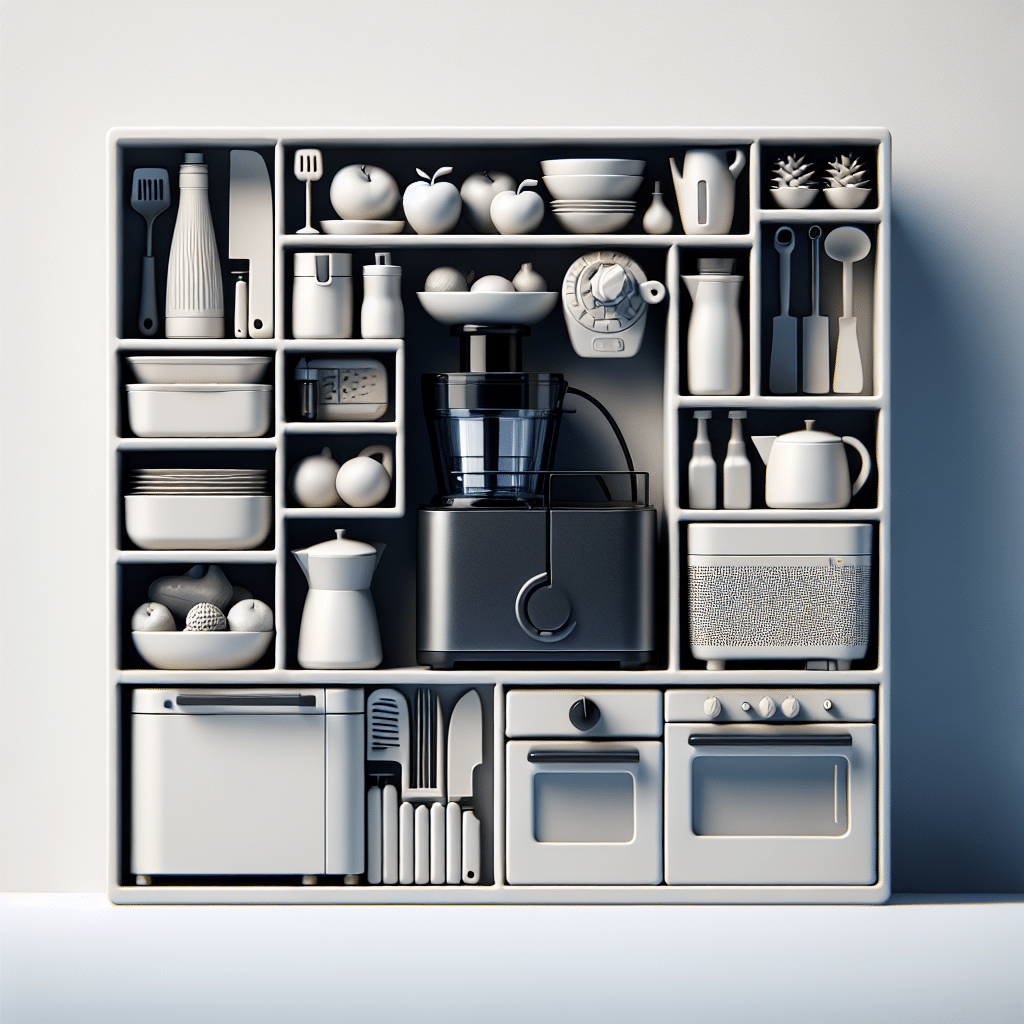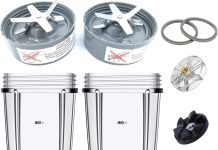If you’ve recently purchased a masticating juicer and find yourself wondering how to store it properly when it’s not in use, you’ve come to the right place. Taking care of your juicer can ensure its longevity and maintain its performance over time. In this article, we’ll explore some tips and tricks on how to store your masticating juicer effectively, keeping it safe and ready for your next juice-making adventure. Whether you’re a seasoned juicing enthusiast or new to the world of slow juicers, these storage guidelines will help you keep your juicer in top condition. So let’s dive in and discover the best ways to store your masticating juicer.
Review contents
Cleaning the juicer after use
After enjoying a refreshing glass of juice, it’s important to properly clean your juicer to maintain its performance and durability. Cleaning your juicer not only helps remove any leftover pulp and residue but also ensures the longevity of the machine. Here are the steps you should follow to clean your juicer thoroughly:
Removing all detachable parts
To begin the cleaning process, you need to remove all detachable parts from the juicer. This usually includes the juice container, pulp container, feeding chute, and any other parts that can be disassembled. By removing these parts, you allow for easier access to every nook and cranny, making the cleaning process more effective.
Rinsing the parts with warm soapy water
Once you have taken apart all the detachable parts, it’s time to give them a good rinse. Use warm soapy water and a gentle brush or sponge to clean each component. Pay extra attention to any crevices or hard-to-reach areas where pulp or juice may have accumulated. Rinse each part thoroughly to ensure all detergent residue is removed.
Drying the parts thoroughly
After washing the detachable parts, it’s crucial to dry them thoroughly. Any residual moisture left on the components can lead to mold or bacteria growth, which can adversely affect the performance and cleanliness of your juicer. Use a clean towel or allow the parts to air dry completely before reassembling the juicer.
Disassembling the juicer for storage
When it’s time to store your juicer, you should disassemble it properly to ensure its safety and longevity. By following these steps, you can easily disassemble your juicer for storage:
Unplugging the juicer
Before disassembling your juicer, always remember to unplug it from the power source. This step is essential to prevent any accidental mishaps or electrical hazards during the disassembly process.
Removing all detachable parts
Similar to the cleaning process, you need to remove all detachable parts from the juicer before storing it. This includes the juicing components, such as the auger, strainer, and juicing screen, as well as any additional attachments or accessories. By removing these parts, you reduce the risk of damage during storage.
Cleaning the parts
Once you have taken apart the juicer, it’s advisable to clean the parts one last time before storage. Even if you have recently cleaned them, it’s beneficial to ensure they are free from any residue or pulp. By maintaining cleanliness, you can prevent any potential degradation of the juicer’s performance while in storage.
Organizing and storing the parts
Keeping all the juicer parts organized and properly stored is crucial to prevent misplacement or damage. Here are some tips to help you keep everything in order:
Keeping all parts together
To avoid the frustration of searching for missing parts when you want to use your juicer again, it’s best to keep all the components together. Designate a specific spot or storage container where you can keep all the parts in one place. This way, you’ll always know where to find them and won’t risk misplacing any essential pieces.
Using the original storage container
If your juicer came with a built-in storage container or bag, it’s wise to use it for storing the parts. The original packaging is designed to fit the different components perfectly, protecting them from potential damage while in storage. If you no longer have the original container, consider investing in a specialized juicer storage container or using a sturdy box specifically dedicated to housing your juicer and its parts.
Labeling the parts
To make the assembly process easier and less time-consuming, consider labeling the different parts of your juicer. Use small adhesive labels or markers to identify each component, ensuring that you can quickly find and assemble them correctly when you want to use the juicer again. This small step can save you valuable time and frustration in the future.
Protecting the juicer from dust and moisture
Dust and moisture can be harmful to your juicer, causing it to malfunction or deteriorate over time. To protect your juicer from these elements, follow these precautions:
Using a dust cover or cloth
To shield your juicer from dust accumulation, cover it with a suitable dust cover or cloth when not in use. This simple step prevents dust particles from settling on the machine’s surfaces, which can affect its performance and cleanliness. Choose a cover that fits snugly over the juicer, providing maximum protection.
Avoiding direct sunlight or extreme temperatures
Exposing your juicer to direct sunlight or extreme temperatures can negatively impact its performance and lifespan. Sunlight can cause discoloration or warping of the machine’s plastic components, while extreme temperatures can lead to mechanical issues. Store your juicer in a cool, shaded area away from direct sunlight and away from any heat sources.
Storing in a dry and cool place
Moisture is another element to be cautious about when storing your juicer. Excessive moisture can corrode metal parts, promote mold growth, and affect electrical components. Choose a storage location that is dry, such as a pantry or cupboard, and ensure there is sufficient ventilation to prevent any moisture accumulation.
Checking and maintaining the juicer periodically
To ensure your juicer remains in optimal condition, it’s important to regularly check and maintain it, even when it’s not in use. Follow these guidelines for periodic maintenance:
Inspecting for any damages or wear
Regularly inspect your juicer for any signs of damage or wear. Check for cracks, loose connections, or worn-out parts that may affect its functionality. By identifying and addressing these issues promptly, you can prevent further damage and extend the juicer’s lifespan.
Cleaning the juicer if needed
Even during storage, some dust or residue may accumulate on your juicer. If you notice any build-up, it’s advisable to clean the juicer before storing it. A quick wipe with a clean cloth or a gentle rinse can keep it in optimal condition, ensuring it’s ready for use whenever you need it.
Ensuring proper storage conditions
During your periodic checks, confirm that your juicer is stored in the ideal conditions. Ensure that the storage location is still dry, cool, and free from any potential risks such as leaks or exposure to extreme temperatures. Taking these preventative measures will help maintain the integrity of your juicer during storage.
Finding the right storage location
Choosing the right storage location for your juicer can contribute to its longevity and ease of use. Consider the following factors when deciding where to store your juicer:
Considering available space
Assess the available space in your kitchen or storage area to determine the most suitable spot for your juicer. Ensure that there is ample room for storing the juicer and its accompanying parts without causing overcrowding or potential damage.
Avoiding areas prone to accidents or spills
Avoid storing your juicer in areas that are prone to accidents or spills. Keep it away from the edge of countertops or shelves to prevent accidental knocking or falling. Additionally, avoid storing it near the sink to minimize the risk of water damage.
Keeping away from children and pets
If you have young children or pets in your household, it’s crucial to store your juicer in a safe and inaccessible location. Place it out of their reach to prevent any potential accidents or damage. Consider utilizing high shelves or locked cabinets to ensure the safety of your juicer and those around it.
Preventing corrosion and rust
Corrosion and rust can significantly impact the functionality and hygiene of your juicer. To prevent these issues, follow these steps:
Ensuring all parts are completely dry
Before storing your juicer, it’s essential to ensure that all parts are thoroughly dry. Moisture can contribute to the formation of rust and corrosion, so take extra care to dry every component meticulously. Use a clean towel or allow the parts to air dry completely before assembling them for storage.
Applying a thin layer of food-safe oil if necessary
If you live in a particularly humid environment or are storing your juicer for an extended period, consider applying a thin layer of food-safe oil to metal parts. This helps create a barrier against moisture, preventing rust formation. Be sure to use a food-grade oil and follow the manufacturer’s instructions for application.
Avoiding moisture-prone areas
Keep in mind that storing your juicer in areas prone to moisture, such as basements or damp rooms, can increase the risk of corrosion and rust. Choose a dry storage location and regularly monitor the area to ensure it remains free from excess humidity.
Protecting the juicer’s power cord
The power cord is an essential part of your juicer, and proper care should be taken to protect it during storage. Consider the following tips to ensure the longevity of the power cord:
Avoiding bending or kinking the cord
To prevent damage to the power cord, avoid bending or kinking it during storage. Improper storage can lead to fraying or internal wire damage, compromising the electrical safety of the juicer. Instead, coil the cord loosely and secure it with cable organizers or ties to maintain its shape and integrity when not in use.
Using cable organizers or ties
To keep the power cord neat and tangle-free, consider utilizing cable organizers or ties. These simple accessories can help prevent the cord from becoming tangled or tripping hazards. Additionally, they allow for easy unwinding and retrieval of the cord when you need to use the juicer again.
Keeping the cord away from heat sources
Heat sources can potentially damage the power cord, affecting its performance and safety. When storing your juicer, make sure to keep the cord away from any heat-emitting appliances or areas. This precaution prevents the cord from melting or becoming brittle due to prolonged exposure to heat.
Storing additional accessories or attachments
Apart from the main juicer components, additional accessories or attachments often come with your juicer. These may include different juicing screens, cleaning brushes, or specialized attachments for specific ingredients. To keep these extra pieces organized and in good condition:
Organizing and keeping them in a separate container
Designate a separate container to store the additional accessories and attachments that come with your juicer. This prevents them from getting lost or damaged. It’s best to choose a container with dividers or compartments to keep the pieces separated and minimize friction or scratching.
Ensuring they are clean and in good condition
Before storing the additional accessories, ensure they are clean and free from any residue or debris. Clean them according to the manufacturer’s instructions, making sure they are thoroughly dry before placing them in the storage container. Regularly inspect the accessories for any signs of wear or damage, replacing them if necessary.
Labeling the container for easy identification
To easily locate specific accessories or attachments, consider labeling the storage container. Use adhesive labels or markers to identify the contents of the container, making it much more convenient to find the required piece when needed. This also helps prevent mixing up accessories from multiple juicer models, ensuring compatibility and optimal performance.
Maintaining the juicer’s warranty
Preserving the warranty of your juicer can be vital, especially if you encounter any unexpected issues or malfunctions. To maintain the validity of your warranty, follow these tips:
Keeping the original packaging
If possible, it’s advisable to retain the original packaging of your juicer. Packaging materials, such as the box and foam inserts, provide ample protection during transportation and are specifically designed to keep the juicer safe. Should any warranty claims arise, having the original packaging can streamline the process.
Retaining the proof of purchase
Always keep a copy of the proof of purchase, such as a receipt or invoice, as proof of ownership and warranty coverage. This document serves as evidence of the juicer’s purchase date and can be required to validate any warranty claims. Store the proof of purchase together with the juicer’s user manual or any warranty cards provided.
Adhering to the manufacturer’s storage instructions
Lastly, make sure to follow the manufacturer’s specific storage instructions to maintain the validity of the warranty. Manufacturers often provide guidelines on how to store their products appropriately, including recommended temperature ranges, specific cleaning procedures, and precautions to avoid common storage issues. Adhering to these instructions ensures the best chance of utilizing your warranty if needed.
By following these comprehensive steps and taking proper care of your masticating juicer, you can ensure its longevity, optimal performance, and the enjoyment of freshly squeezed juices for years to come. Remember, cleaning, disassembling, organizing, and protecting your juicer are all essential aspects of proper storage and maintenance. With a little effort, your juicer will remain in great condition, ready to provide you with delicious and healthy juices whenever you desire!


































